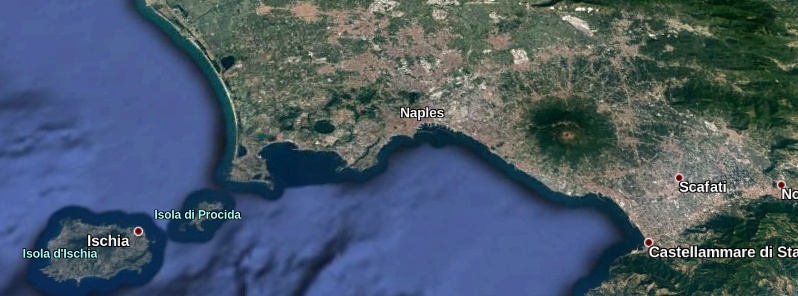Large-scale pre-historic Campi Flegrei eruption identified, reducing recurrence interval – Naples, Italy

University of Oxford researchers have traced the origin of a large-scale pre-historic eruption that blanketed the Mediterranean region in ash 29 000 years ago to Campi Flegrei volcano, located near the city of Naples, Italy (population 970 000). The research drastically reduces the volcano's eruption recurrence interval.
This research positions the timing of this previously un-reported large-scale eruption of Campi Flegrei between two well-known large-scale eruptions of the volcano, at 15 000 and 40 000 years ago, drastically reducing the recurrence interval of large magnitude eruptions at the volcano.
Since the late 1970s scientists have identified the same pre-historic volcanic ash layer in sediment cores extracted from sites ranging across 150 000 km2 (58 000 mi2) of the central Mediterranean. This widespread ash layer clearly indicated a large volcanic eruption. Although the region is well known for its many active volcanoes, such as Mount Vesuvius which famously destroyed Pompeii in 79 AD, scientists had failed to confidently match this older, far-ranging ash deposit to a specific volcano or eruption.
Dr. Paul Albert, a Research Fellow in the School of Archaeology, has now identified an ash rich-eruption deposit within the city of Naples which was produced by Campi Flegrei volcano and has a chemical composition that matches the prehistoric ash layer traced across the Mediterranean region.
"Part of the challenge of reliably attributing this major ash fall event to Campi Flegrei volcano has been that there is limited evidence for a large eruption close to the volcano," says Albert. "This is in part because a more recent large-scale eruption of the volcano buried the Naples area in a thick ash deposit, largely destroying or concealing the evidence of this older event," he added.
"By linking the thickness of the ash deposits found in Naples, to those preserved in cores from across the central Mediterranean, the model was able to demonstrate and provide important constraints on the size of this large magnitude eruption," says Albert.
The research, published in the journal Geology, also highlights the importance of considering ash fall events preserved well away from the volcano when reconstructing the timing and scale of past explosive eruptions.
"Ashfall preserved hundreds of kilometers away from the volcano has been critical here in the identification and reconstruction of this large eruption at Campi Flegrei," Albert said.
The last eruption of this volcano took place in 1528.
Campi Flegrei is a large 13-km-wide caldera on the outskirts of Naples that contains numerous phreatic tuff rings and pyroclastic cones. The caldera margins are poorly defined, and on the south lie beneath the Gulf of Pozzuoli.
Episodes of dramatic uplift and subsidence within the dominantly trachytic caldera have occurred since Roman times.
The earliest known eruptive products are dated 47 000 yrs BP, according to the Global Volcanism Program.
The caldera formed following two large explosive eruptions, the massive Campanian ignimbrite about 36 000 BP, and the over 40 km3 Neapolitan Yellow Tuff (NYT) about 15 000 BP. Following eruption of the NYT a large number of eruptions have taken place from widely scattered subaerial and submarine vents.
Most activity occurred during three intervals: 15 000 – 9 500, 8 600 – 8 200, and 4 800 – 3 800 BP. Two eruptions have occurred in historical time, one in 1158 at Solfatara and the other in 1538 that formed the Monte Nuovo cinder cone.
Read more: Eruption of Campi Flegrei possibly closer than thought, Italy – TW, May 15, 2017
Featured image credit: Google Earth

Commenting rules and guidelines
We value the thoughts and opinions of our readers and welcome healthy discussions on our website. In order to maintain a respectful and positive community, we ask that all commenters follow these rules:
We reserve the right to remove any comments that violate these rules. By commenting on our website, you agree to abide by these guidelines. Thank you for helping to create a positive and welcoming environment for all.